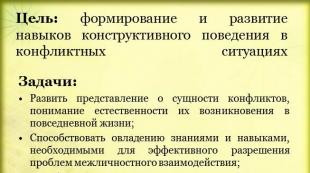Axial symmetry in animate and inanimate nature. Symmetry in nature Message on the topic of symmetry in life
Symmetry of points with respect to a straight line Symmetry of points with respect to a straight line Symmetry of a figure with respect to a straight line Symmetry of a figure with respect to a straight line Symmetry of points with respect to a point Symmetry of points with respect to a point Symmetry of a figure with respect to a point Symmetry of a figure with respect to a point Symmetry around usSymmetry around us Mathematics about symmetryMathematics about symmetry



Definition Two points A and A 1 are called symmetrical with respect to a line a if this line passes through the midpoint of the segment AA 1 and is perpendicular to it. Task Construct a point C 1 symmetrical to point C with respect to a line a A1A1 A a O B A A1A A1 a T AO \u003d OA 1 C1C1 a C

Definition A figure is called symmetrical with respect to a line if for each point of the figure the point symmetrical to it also belongs to this figure A figure is called symmetrical with respect to the line if for each point of the figure the point symmetrical to it also belongs to this figure A D B C M K N P ab c


Definition Points A and A 1 are called symmetrical with respect to the point O, if O is the midpoint of the segment AA 1 Points A and A 1 are called symmetrical with respect to the point O, if O is the midpoint of the segment AA 1 Construct a segment A 1 B 1 symmetrical to segment AB about the point O A O A B B1B1 O A1A1 A1A1

Definition A figure is called symmetric with respect to a point if for each point of the figure the point symmetric to it also belongs to this figure. A figure is called symmetric with respect to a point if for each point of the figure the point symmetric to it also belongs to this figure. Which of these figures has a center of symmetry? A B C D O












Symmetry in Literature A palindrome is the absolute manifestation of symmetry in literature. For example: “And the moon has sunk”, “And the rose has fallen on the paw of Azor”. V. Nabokov's palindrome: I ate elk meat, melting... Tore Eol aloe, laurel. Those to him: "Look! And he knows how to tear!" He told them: "I am a minotaur!" He told them: "I am a minotaur!" back


A mathematician loves symmetry first of all Maxwell D. Maxwell D. Beauty is closely related to symmetry Weil G. Weil G. Symmetry ... is the idea through which man has tried for centuries to comprehend and create order, beauty and perfection Weil G. Weil G. For The symmetry of the human mind seems to have a very special attraction Feynman R. Feynman R.

Conclusion Symmetry plays a huge role in art: in architecture, in music, in poetry; nature: in plants and animals; in technology, in everyday life. Symmetry plays a huge role in art: in architecture, in music, in poetry; nature: in plants and animals; in technology, in everyday life.


If there were no symmetry, what would our world look like? What would be considered the standard of beauty and perfection? What does central symmetry mean for us and what role does it play? By the way, one of the most significant. To understand this, let's get acquainted with the natural law of nature closer.
Central symmetry
First, let's define the concept. What do we mean by the phrase "central symmetry"? This is proportionality, ratio, proportionality, exact similarity of the sides or parts of something relative to a conditional or well-defined rod axis.
Central symmetry in nature
Symmetry can be found everywhere if you look closely at the reality around us. It is present in snowflakes, leaves of trees and grasses, insects, flowers, animals. The central symmetry of plants and living organisms is completely determined by the influence of the external environment, which still forms the appearance of the inhabitants of planet Earth.

Flora
Do you like picking mushrooms? Then you know that a mushroom cut vertically has an axis of symmetry along which it forms. You can observe the same phenomenon in round, centrally symmetrical berries. And what a beautiful cut apple! Moreover, absolutely in every plant there is some part that has developed according to the laws of symmetry.
Fauna

To notice the symmetry of insects, fortunately, they do not need to be dissected. Butterflies, dragonflies - like revived and fluttering flowers. Graceful predators and domestic cats... You can endlessly admire the creations of nature.
water world

How infinite is the species diversity of the inhabitants of the aquatic environment, so often there is central symmetry there. Surely everyone can give a few simple examples.
Central symmetry in life

Throughout its centuries-old history from ancient temples, medieval castles and up to the present, man has known beauty, harmony and learned to create by observing nature. The urban world, in which the majority of the world's population lives, is full of symmetry. These are houses, appliances, household items, science and art. Analogy is the key to the success of any engineering structure.
Symmetry in art

Central symmetry is not only a mathematical concept. It is present in all spheres of human life. The harmony of the rhythmic composition has never left a person indifferent. The reflection of these principles can be found in the arts and crafts: embroidery by authentic craftswomen of completely different nations, patterned woodcarving, self-woven carpets. There is a uniform construction of repetitions even in oral songwriting and the art of versification! And, of course, craftsmen made jewelry according to the same laws of central symmetry. It is then that the decoration takes on individuality, unique beauty and becomes a real work of art. This is how symmetry educates humanity, revealing the magical principle of order, harmony and perfection.
Since ancient times, man has developed ideas about beauty. All creations of nature are beautiful. People are beautiful in their own way, animals and plants are delightful. The spectacle of a precious stone or a salt crystal pleases the eye, it is difficult not to admire a snowflake or a butterfly. But why is this happening? It seems to us that the appearance of objects is correct and complete, the right and left halves of which look the same, as in a mirror image.
Apparently, people of art were the first to think about the essence of beauty. Ancient sculptors who studied the structure of the human body, back in the 5th century BC. began to use the concept of "symmetry". This word is of Greek origin and means harmony, proportionality and similarity in the arrangement of the constituent parts. Plato argued that only that which is symmetrical and proportionate can be beautiful.
In geometry and mathematics, three types of symmetry are considered: axial symmetry (with respect to a straight line), central (with respect to a point) and mirror (with respect to a plane).
If each of the points of an object has its own exact mapping relative to its center within it, then there is a central symmetry. Its examples are such geometric bodies as a cylinder, a ball, a regular prism, etc.

Axial symmetry of points relative to a straight line provides that this straight line intersects the midpoint of the segment connecting the points and is perpendicular to it. Examples of a bisector of a non-expanded angle of an isosceles triangle, any line drawn through the center of a circle, etc. If axial symmetry is characteristic, the definition of mirror points can be visualized simply by bending it along the axis and folding equal halves “face to face”. The desired points will touch each other.
With mirror symmetry, the points of the object are located equally relative to the plane that passes through its center.
Nature is wise and rational, therefore almost all her creations have a harmonious structure. This applies to both living beings and inanimate objects. The structure of most life forms is characterized by one of three types of symmetry: bilateral, radial or spherical.

Most often, axial can be observed in plants that develop perpendicular to the soil surface. In this case, symmetry is the result of rotating identical elements around a common axis located in the center. The angle and frequency of their location may be different. Trees are an example: spruce, maple and others. In some animals, axial symmetry also occurs, but this is less common. Of course, mathematical precision is rarely inherent in nature, but the similarity of the elements of an organism is still striking.
Biologists often consider not axial symmetry, but bilateral (bilateral). Its examples are the wings of a butterfly or dragonfly, plant leaves, flower petals, etc. In each case, the right and left parts of the living object are equal and are mirror images of each other.

Spherical symmetry is characteristic of the fruits of many plants, some fish, mollusks and viruses. And examples of ray symmetry are some types of worms, echinoderms.
In the eyes of a person, asymmetry is most often associated with irregularity or inferiority. Therefore, in most of the creations of human hands, symmetry and harmony can be traced.
SECONDARY EDUCATIONAL SCHOOL № 55
SOVETSKY DISTRICT CITY OF VORONEZH
Research work
on the topic:
"Symmetry in human life"
Completed by student
8 "B" class:
Mitin Alexey
Supervisor:
mathematic teacher
Belyaeva M.V.
Voronezh, 2015
Table of contents:
Relevance of the topic.
Symmetry and its types.
Symmetry in art.
Architecture;
Painting;
Literature and music.
Symmetry and technique.
Symmetry in different sciences.
Biology;
Physics;
Chemistry.
Conclusions.
Used Books.
Relevance of the topic.
The beauty of many forms is based on symmetry or its types. This topic is very extensive and affects, in addition to mathematics, many other areas of science, art, and technology. It is symmetry that prevails in nature over asymmetry. Not everyone can imagine or remember any asymmetric animal, because there are not many of them, and mostly these are various bacteria or simple organisms, as well as animals that have received the property of asymmetry due to necessity. Knowledge of nature and life is the first task of man. And one of the main steps towards this goal is the knowledge of symmetry.
Symmetry is the idea with which man has been trying for centuries to explain and create order, beauty and perfection.
Herman Weil
Research objectives:
to study the concepts of symmetry and its types (central, axial, rotary, mirror, etc.),
conduct research on the study of symmetry phenomena in biology, physics, architecture, painting, literature, transport and technology;
acquisition of skills of independent work with large volumes of information.
Symmetry and its types.
The concept of symmetry began to take shape a very long time ago. The study of archaeological sites shows that humanity at the dawn of its culture already had an idea of \u200b\u200bsymmetry and carried it out in drawing and in household items. Now it is widely used in many areas of modern science.
Symmetry is proportionality, proportionality in the arrangement of parts of something on both sides of the center.
For centuries, symmetry has remained a subject that fascinates philosophers, astronomers, mathematicians, artists, architects and physicists. The ancient Greeks were completely obsessed with it - and even today we tend to see symmetry in everything from furniture arrangement to hair cutting.
There are three main types of symmetry: mirror, axial and central. There are also sliding, helical, point, translational, fractal and other types of symmetry.
Axial Symmetry: Two points are said to be symmetrical with respect to a line if that line passes through the midpoint of the segment connecting these points and is perpendicular to it. Each point of this line is considered symmetrical to itself. A figure is called symmetrical with respect to a line if for each point of the figure the point symmetrical to it with respect to the line also belongs to this figure. The figure is also said to have axial symmetry. Classical figures with such symmetry will be a circle, a rectangle, a rhombus, a square, and they will have several axes of symmetry. Under axial symmetry, also in the natural sciences, rotational or radial symmetry is accepted - a form of symmetry in which a figure coincides with itself when an object rotates around a certain straight line. The center of symmetry of an object is the line on which all axes of bilateral symmetry intersect. Radial symmetry is possessed by geometric objects such as a circle, a ball, a cylinder, or a cone. 

Central symmetry: two points A and A 1 are said to be symmetric with respect to point O if O is the midpoint of segment AA 1 . A figure is called symmetric with respect to the point O if for each point of the figure the point symmetric to it with respect to the point O also belongs to this figure. Point O is called the center of symmetry of the figure. This means that the figure has central symmetry. 


Examples of figures that have this symmetry would be a circle and a parallelogram. The center of symmetry of a circle is the center of this circle, and the center of a parallelogram is the point of intersection of its diagonals. The simplest example I can give is plants, in almost any plant you can find a part that has central or axial symmetry, but the flower itself will have central symmetry only in the case of an even number of petals.
Mirror symmetry is such a mapping of space onto itself, in which any point M goes into a point M 1 symmetric to it with respect to this plane α. When we look in a mirror, we observe our reflection in it - this is an example of “mirror” symmetry. Mirroring is an example of a so-called "orthogonal" transformation that changes orientation. I think the reflection in the river would also be a good example of mirror symmetry. This symmetry is also called in other sciences bilateral and bilateral. It is especially noticeable in architecture, as well as in the animal world. A person also has it, and if you mentally draw a line in the center, then the right side will correspond to the left. 
Symmetry in art.
We admire the beauty of the world around us and do not think about what underlies this beauty. Science and art are the two main principles in human culture, two complementary forms of the highest creative activity of man. Symmetry in art plays a huge role and almost no architectural structure can do without it.
Fine examples of symmetry are demonstrated by works of architecture. Science, technology and art are closely connected and strictly balanced in it. People have always sought to achieve harmony in architecture. Thanks to this desire, new inventions, designs and styles were born. Human creativity in all its manifestations gravitates toward symmetry. The famous French architect Le Corbusier spoke well on this subject, in his book “Architecture of the 20th century” he wrote: “A person needs order: without it, all his actions lose their coherence, logical reciprocity. The more perfect the order, the calmer and more confident a person feels. Architectural structures created by man are mostly symmetrical. They are pleasing to the eye, people consider them beautiful. Symmetry is perceived by a person as a manifestation of regularity, and therefore, of internal order. Externally, this internal order is perceived as beauty. Buildings of Ancient Egypt, amphitheatres, triumphal arches of the Romans, palaces and churches of the Renaissance, as well as numerous buildings of modern architecture are subject to mirror symmetry. The symmetry of a structure is associated with the organization of its functions. The projection of the plane of symmetry - the axis of the building - usually determines the location of the main entrance and the beginning of the main traffic flows. The school where I study also has this type of symmetry.
In art there is a mathematical theory of painting. This is perspective theory. Perspective is the doctrine of how to convey on a flat sheet of paper a sense of the depth of space, that is, to convey to others the world as we see it. It is based on the observance of several laws. The laws of perspective lie in the fact that the farther an object is from us, the smaller it seems to us, completely fuzzy, it has fewer details, its base is higher. The symmetrical composition is easily perceived by the viewer, immediately drawing attention to the center of the picture, in which the main thing, relative to which the action unfolds, is located. Renaissance painters often built their compositions according to the laws of symmetry. This construction allows you to achieve the impression of peace, majesty, special solemnity and significance of events. A person distinguishes objects around him by shape. Interest in the form of an object may be dictated by vital necessity, or it may be caused by the beauty of the form. The form, which is based on a combination of symmetry and the golden section, contributes to the best visual perception and the appearance of a sense of beauty and harmony. The whole always consists of parts, parts of different sizes are in a certain relationship to each other and to the whole.
In music and literature, symmetry and certain proportions are also observed. For example, in the second half of the 19th century, analyzing the works of Bach, E.K. Rosenov came to the conclusion that they "dominate the law of the golden section and the law of symmetry." In his study, the golden ratio is considered as a condition for the proportionality of a musical work, while the golden ratio should solve three problems: 1) Establish a proportional relationship between the whole and its parts; 2) to be a special place for the satisfaction of the prepared expectation in relation to the whole and its parts; 3) to direct the listener's attention to those parts of the musical work to which the author attaches the greatest importance in connection with the main idea of the work. In the work of M.A. Marutaev, the golden section, along with the so-called qualitative and broken symmetry, is regarded as a prerequisite for harmony in music. Works devoted to the study of the golden section in music play an important role in comprehending the specifics of musical art. The most common type of symmetry in music is the translational type. In this case, a musical phrase, melody, or larger passages of a piece of music are repeated, remaining unchanged. All songs that repeat the chorus multiple times will have this kind of symmetry.
The proportion and symmetry of an object is always necessary for our visual perception in order for us to consider this object beautiful. The balance and proportion of the parts, relative to the whole, are indispensable for symmetry. Looking at symmetrical images is more pleasant than asymmetric ones. It is difficult to find a person who did not admire the ornaments. You can find an intricate combination of different types of symmetry in them.
Symmetry in technology.
Technical objects - airplanes, cars, rockets, hammers, nuts - almost all of them, from the smallest technical devices to huge rockets, have one or another symmetry, and this is not accidental. In technology, beauty, the proportionality of mechanisms is often associated with their reliability, stability in operation. The symmetrical shape of an airship, aircraft, submarine, car, etc. provides good streamlining with air or water, and hence minimal resistance to movement. Any machine, machine, device, mechanism, unit must be assembled around the established symmetry. At the dawn of the development of aviation, our famous scientists N. E. Zhukovsky and S. A. Chaplygin studied the flight of birds in order to draw conclusions about the best form of the wing and the conditions for its flight. Symmetry played a big role in this, of course. Even modern combat fighters such as the Su-27, MiG-29 and T-50 are basically designed according to the laws of symmetry.



Symmetry in different sciences.
All representatives of the animal kingdom - mammals, birds, fish, insects, worms, arachnids, etc., in their external forms and the structure of their skeleton, show us mirror symmetry, i.e., the equality of right and left. Considering any of these living beings, we can mentally draw a vertical plane through it, relative to which what is located on the right will be a mirror image of what is located on the left, and vice versa. This equality is not fulfilled with an accuracy of fractions of a millimeter, maybe not even up to a millimeter, but, nevertheless, with a certain degree of approximation, mirror symmetry is evident. Visually, we perceive living organisms as symmetrical. Reflections are understood as any mirror reflections - at a point, line, plane. The imaginary plane that divides the figures into two mirror halves is called the plane of symmetry. A butterfly, a leaf of a plant are the simplest examples of figures that have only one plane of symmetry, dividing it into two mirror equal parts. Therefore, this type of symmetry in biology is called bilateral or bilateral. It is believed that such symmetry is associated with differences in the movements of organisms up - down, forward - backward, while their movements to the right - to the left are exactly the same. Violation of bilateral symmetry inevitably leads to deceleration of the movement of one of the parties and a change in the translational movement. Therefore, it is no coincidence that actively mobile animals are bilaterally symmetrical. But this kind of symmetry is also found in immobile organisms and their organs. It arises in this case due to the unequal conditions in which the attached and free sides are located. Apparently, this explains the bilaterality of some leaves, flowers and rays of coral polyps. The specificity of the structure of plants and animals is determined by the characteristics of the habitat to which they adapt, the characteristics of their lifestyle. Any tree has a base and a top, "top" and "bottom" that perform different functions. The significance of the difference between the upper and lower parts, as well as the direction of gravity determine the vertical orientation of the "tree cone" rotary axis and symmetry planes. Leaves are mirror symmetrical. The same symmetry is also found in flowers, however, in them, mirror symmetry often appears in combination with rotational symmetry. Rotational symmetry is a symmetry in which an object is aligned with itself when rotated through 360°/n. There are often cases of figurative symmetry (twigs of acacia, mountain ash). Interestingly, in the flower world, the rotational symmetry of the 5th order is most common, which is fundamentally impossible in the periodic structures of inanimate nature. Academician N. Belov explains this fact by the fact that the 5th order axis is a kind of instrument of the struggle for existence, "insurance against petrification, crystallization, the first step of which would be their capture by a lattice." Indeed, a living organism does not have a crystalline structure in the sense that even its individual organs do not have a spatial lattice. However, ordered structures are very widely represented in it. Our further searches were focused on central symmetry. It is most characteristic of flowers and fruits of plants. Central symmetry is characteristic of various fruits, but we settled on berries: blueberries, blueberries, cherries, cranberries. Consider a section of any of these berries. In section, it is a circle, and the circle, as we know, has a center of symmetry. Central symmetry can be observed in the image of the following flowers: dandelion flower, coltsfoot flower, water lily flower, chamomile core, and in some cases the image of the entire chamomile flower also has central symmetry.
Symmetry is one of the fundamental concepts in modern physics, which plays an important role in the formulation of modern physical theories. The symmetries taken into account in physics are quite diverse, some of them are considered exact in modern physics, others are only approximate. In 1918, the German mathematician Noether proved a theorem according to which each continuous symmetry of a physical system corresponds to a certain conservation law. The presence of this theorem makes it possible to analyze a physical system based on the available data on the symmetry that this system possesses. From it, for example, it follows that the symmetry of the equations of motion of a body over time leads to the law of conservation of energy; symmetry with respect to shifts in space - to the law of conservation of momentum; symmetry with respect to rotations - to the law of conservation of angular momentum. If the laws that establish relationships between the quantities that characterize a physical system, or determine the change in these quantities over time, do not change under certain operations that the system can be subjected to, then these laws are said to have symmetry with respect to these transformations.
| Symmetry in physics |
||
| Transformations | Relevant invariance | Relevant law conservation |
| ↕ Broadcast time | Uniformity time | …energy |
| ⊠ C, P, CP and T - symmetries | Isotropy time | ... parity |
| ↔Space broadcasts | Uniformity space | …impulse |
| ↺ Rotation of space | Isotropy space | … moment momentum |
| ⇆ Lorentz group | Relativity Lorentz invariance | …4-pulses |
| ~ Gauge transformation | Gauge invariance | ... charge |
Supersymmetry is a hypothetical symmetry relating bosons and fermions in nature. The abstract supersymmetry transformation links the bosonic and fermionic quantum fields so that they can turn into each other. Figuratively, we can say that the supersymmetry transformation can transform matter into interaction (or into radiation), and vice versa. As of 2015, supersymmetry is a physical hypothesis that has not been experimentally confirmed. It has been absolutely established that our world is not supersymmetric in the sense of exact symmetry, since in any supersymmetric model fermions and bosons bound by a supersymmetric transformation must have the same mass, charge and other quantum numbers. This requirement is not met for particles known in nature. Regardless of the existence of supersymmetry in nature, the mathematical apparatus of supersymmetric theories turns out to be useful in various fields of physics. In particular, supersymmetric quantum mechanics makes it possible to find exact solutions of highly non-trivial Schrödinger equations. Supersymmetry turns out to be useful in some problems of statistical physics.
Symmetry in chemistry is manifested in the geometric configuration of molecules. Most simple molecules have elements of spatial symmetry of the equilibrium configuration: axes of symmetry, planes of symmetry, etc. The usual way of representing molecules in organic chemistry is through structural formulas. In 1810, D. Dalton, wishing to show his listeners how atoms combine to form chemical compounds, built wooden models of balls and rods. These models have proven to be excellent visual aids. The molecule of water and hydrogen has a plane of symmetry. Nothing will change if you swap paired atoms in a molecule; such an exchange is equivalent to a mirroring operation. 
Crystals bring the charm of symmetry to the world of inanimate nature. Each snowflake is a small crystal of frozen water. The shape of snowflakes can be very diverse, but they all have rotational symmetry and, in addition, mirror symmetry. A crystal is a solid body that has the natural shape of a polyhedron. Salt, ice, sand, etc. are made up of crystals. First of all, Romeu-Delille emphasized the correct geometric shape of crystals based on the law of constancy of the angles between their faces. He wrote: “All the bodies of the mineral kingdom began to be attributed to the category of crystals, for which the figure of a geometric polyhedron was found ...” The correct form of crystals arises for two reasons. First, crystals are composed of elementary particles - molecules that themselves have the correct shape. Secondly, "such molecules have a remarkable property to connect with each other in a symmetrical order." Why are crystals so beautiful and attractive? Their physical and chemical properties are determined by their geometric structure.
Conclusion.
There are many types of symmetry, both in the plant and animal kingdoms, but with all the diversity of living organisms, the principle of symmetry always works, and this fact once again emphasizes the harmony of our world. The human idea of beauty is formed under the influence of what a person sees in wildlife. In her creations, very far from each other, she can use the same principles. And man in painting, sculpture, architecture, music applies the same principles. The fundamental principles of beauty are proportions and symmetry. Without symmetry, our world would look very different. After all, it is precisely on symmetry that many laws are based. Almost everything around us has some form of symmetry. You can talk about it endlessly. Symmetry, manifesting itself in the most diverse objects of the natural world, undoubtedly reflects its most general properties. Therefore, the study of symmetry and comparison with the results is a convenient and reliable tool for understanding the harmony of the world.
Mathematics reveals order, symmetry and certainty, and these are the most important types of beauty.
Aristotle
Used Books.
en.wikipedia.org
www.allbest.ru
www.900igr.net
Tarasov L. V. This amazing symmetrical world - M.: Enlightenment, 1982.
Urmantsev Yu.A. Symmetry in nature and the nature of symmetry - M .: Thought, 1974.
Ozhegov S.I. Dictionary of the Russian language - M .: Rus. Yaz., 1984.
L.S. Atanasyan Geometry, 7-9 - M.: Enlightenment, 2010.
L.S. Atanasyan Geometry, 10-11 - M .: Education, 2013.
Weil G. Symmetry. Translation from English by B.V. Biryukov and Yu.A. Danilova - M .: Publishing house "Nauka", 1968.
The text of the work is placed without images and formulas.
The full version of the work is available in the "Job Files" tab in PDF format
1. Symmetry……………………………………………………….......................... .....four
1.1. What is symmetry? .............................................................. .....................................four
1.2. Types of symmetry…………………………………………………….…..…5
1.3. Symmetry in mathematics…..………………………………….….………….7
1.4. Symmetry in Russian..………………………………..……………8
1.5. Symmetry in the surrounding world………………………..…….………….9
2. Symmetry around us…………………………………………………………….….13
3. The role of symmetry…………………………………………………………….…….…...15
Conclusion………………………………………………………………….…….…..16
List of sources used………………………………………………..17
Introduction
We studied symmetry in math class, but it turned out that little time is devoted to this topic. And I wanted to learn more about symmetry.
In this work, we will consider the concept of "symmetry" more broadly, not limited to the framework of mathematics. The world around us is largely symmetrical - insects and animals, flowers and trees, household items and architectural structures have symmetry.
Research objectives:
The study of the concept of "symmetry";
What role does symmetry play?
Symmetry around us.
Research objectives;
Prove why symmetry is important;
Consider the types of symmetry, and where it occurs;
Conduct an experiment and find out if a person's face is symmetrical;
The object of research is symmetry, and the subject is symmetry in nature and the surrounding world.
During the work, observation methods, questioning, experiment and theoretical analysis were used.
Symmetry
1.1.What is symmetry?
To find out what elementary school children know, we conducted a survey of what symmetry is and where it is found. It was attended by 90 people.
From the survey, we learned that students know little where symmetry occurs and what it is.
We got the following results:
Only 9 people know the correct answer to the first question. On the second
question - 16 people. Most correct answers to the third question -
57 people.
After reading encyclopedias and textbooks, I learned that nature creates the most perfect forms, and it is she who gives these forms unusually harmonious color combinations (butterfly, wasp, dragonfly). Since ancient times, people have used symmetry in drawings, ornaments, and household items. I paid attention to how strictly symmetrical forms of ancient buildings, ancient Greek vases are harmonious, their ornaments are proportionate. With one or another manifestation of symmetry, we meet literally at every step.
So what is symmetry? We looked at several sources. In the explanatory dictionary S.I. Ozhegov:
Symmetry is proportionality, the sameness in the arrangement of parts of something on opposite sides of a point, line or plane.
In the explanatory dictionary of V.I. Dalia:
Symmetry (Greek) - proportionality, correspondence, similarity;
In the Great Soviet Encyclopedia:
Symmetry is a property of a geometric figure that characterizes a certain regularity of the form, its invariance under the action of movements and reflections.
Of the definitions found, the most understandable for me was the definition given by S.I. Ozhigov. Definitions are different, but in all there is the word proportionality.
Types of symmetry
Mathematics is the queen of all sciences, a symbol of wisdom. The beauty of mathematics among the sciences is unattainable, and beauty is one of the links between science and art. This is not only a harmonious system of laws, but also a unique means of knowing beauty. In mathematics, various types of symmetry are considered. Each of them has its own name.
In nature, the following types of symmetry are most common - "mirror", axial, central symmetry.
Butterfly, leaf or beetle has “mirror” symmetry, and often this kind of symmetry is called “leaf symmetry”. The forms with radial symmetry include mushroom, chamomile, pine tree. And the mirror not only copies the object, but also swaps the front and back parts of the object with respect to the mirror.
I looked in the mirror and thought that my left hand in the mirror is my right hand and vice versa.
I learned that in the school course of geometry three types of symmetry are considered: symmetry about a point (central symmetry); symmetry relative to a straight line (axial or mirror symmetry); symmetry about the plane. Central symmetry .Two points A and A1 are called symmetrical with respect to the point O if O is the midpoint of the segment AA1. Point O is considered symmetrical to itself.
Axial symmetry. The transformation of a figure F into a figure F1, in which each of its points goes to a point symmetric with respect to a given line, is called a symmetry transformation with respect to a line a. Straight a called the axis of symmetry.
In order to see this, fold a piece of paper in half and pierce it with a needle. Unfold the sheet. We find two points A and B on it. We draw the segment AB and denote by the letter O its intersection with the line L. The segments AO and BO are equal.
Mirror symmetry . Mirror symmetry is a mapping of space onto itself, in which any point goes to a point symmetrical to it, relative to the plane.
In space, the analogue of the axis of symmetry is the plane of symmetry. The mapping of space onto itself with respect to the plane is called mirror symmetry. This name is justified by the fact that both parts of the figure, located on opposite sides of the plane of symmetry, are similar to some object and its reflection in the mirror.
We have a pond in the village, where the inhabitants of our village like to go to rest. It is very beautiful on its coast. Quiet. Nothing wobbles. Birches, bushes, reeds are reflected in the water. That's some kind of mirror symmetry!
Rotational symmetry . Rotational symmetry is a symmetry in which an object is aligned with itself when rotated around a certain axis through certain angles.
This symmetry is found in flowers. I tried to rotate the chamomile, everything worked out. I consider the arrangement of leaves on a tree branch, I see that one leaf is not only at a distance from the other, but also rotated around the axis of the trunk. What for? The encyclopedia says that the leaves are located on the trunk along a helical line (the principle of helical symmetry), so as not to obscure sunlight from each other.
Portable symmetry. If, when transferring a flat figure F along a given straight line AB to a distance a(or a multiple of this value) the figure is combined with itself, then they speak of portable symmetry. Straight line AB is called the transfer axis, the distance a elementary transfer.
Symmetry in mathematics
Symmetry also occurs in our usual math lessons, for example:
In geometric shapes: square, rectangle, triangle, circle.
Mirror symmetry in numbers.
Numbers consisting of the numbers 8 and 0 are symmetrical.
The signs of arithmetic operations, double and curly brackets are also symmetrical:
+ = : () ( ) X
When studying the topic "Units of mass", we get acquainted with the scales. Scales in balance are symmetrical!
When studying the multiplication and division table, we saw that the numbers and answers in it are located symmetrically about the diagonal axis of symmetry.
Symmetry in Russian
In the Russian language lesson, we noticed that there is also symmetry, for example:
In letters:
In words:
A mirror anagram is a kind of anagram, a phrase (or one word) obtained by reading another phrase in the reverse order, for example, "thief" - "ditch".
Examples of mirror anagrams
azu—bondage;
beech - cube;
march - scar;
disco - oxide;
Milan - burbot;
Mirror anagrams are similar to palindromes, but for palindromes, the meaning does not change when read back (Appendix 1).
Hut, Cossack, radar, cook, Anna, pop, Alla.
And the rose fell on Azor's paw.
The shortest palindrome in Russian consists of only one letter - O!.
When underlining sentence members:
Predicate addition definition circumstance
Our textbook on the Russian language uses the following conventions, they are symmetrical:
Symmetry in the world
In the lessons "The world around us" we study animate and inanimate nature.
The butterfly is a prime example of mirror symmetry. You can swap the right and left halves without changing the object.
Also, examples of symmetry can be found when considering plants.
Central symmetry Axial symmetry
We noticed the symmetry when looking at the flags of different states.
Canada Azerbaijan United Kingdom
Vietnam Bahamas
Man is also an object of living nature. And I wondered if a person's face is symmetrical? In order to find the answer to this question, we will conduct an experiment.
We draw a vertical axis of symmetry:
Copy the left side. They did the same with the right.
Combined two left halves:
Combined two right halves:
After conducting an experiment, we came to the conclusion that a person's face is not symmetrical, as it seems at first glance.
Symmetry around us
We meet with symmetry everywhere - in nature, technology, art, science. Since ancient times, man has used symmetry in architecture. It gives harmony and completeness to ancient temples, towers, medieval castles, modern buildings. Symmetry literally permeates the entire world around us.
Each snowflake is a small crystal of frozen water. The shape of snowflakes can be very diverse, but they all have symmetry.
Symmetry in technology is observed very often. I think people do it because it's more convenient to use such a technique.
Symmetry is also used in everyday life, for example, ornaments and borders, dishes, interior items, clothing.
Symmetry is found even in poetry and music.
“The soul of music - rhythm - consists in the correct periodic repetition of parts of a musical work,” wrote the famous Russian physicist G.V. Wulf. The correct repetition of the same parts as a whole is the essence of symmetry.
The composer in his symphony can return to the same theme several times, gradually revealing it.
In poems, the symmetry of the alternation of rhymes, stressed syllables is implied.
Everything is bright, everything is white ohm.
Light knots on the glass ora,
Forty merry for two re,
Trees in the winter re,
And softly lined ora
Winter's resplendent carpet ohm.
Pushkin A.S. "Eugene Onegin"
Thus, I realized that symmetry in my life is found everywhere, you just need to be attentive and observant.
The role of symmetry
We got acquainted with the concept of symmetry and its types.
Now I'm thinking, what role does symmetry play?
I asked the guys to help complete the task.
Task: It is necessary to draw a symmetrical half and an asymmetrical one. Make a conclusion (Appendix 2).
Conclusion: In these drawings, symmetrical objects look more harmonious than asymmetrical ones.
Symmetry is order, predictability, stability. A person loves order, predictability, stability, so symmetrical objects seem more beautiful to him.
At the same time, slight deviations from symmetry give the object individuality, and this is also good. For example, if all Christmas trees were completely symmetrical, then we would hardly like the spruce forest. And small deviations from symmetry made it possible to turn the vase into a jug...
Conclusion
For centuries, symmetry remained the property that occupied the minds of philosophers, astronomers, mathematicians, artists, architects, and we began to study symmetry with great pleasure.
In the course of this work, we got acquainted with several types of symmetry: “mirror”, axial and central. We found where she is hiding and realized that symmetry is found everywhere: in animate and inanimate nature, in technology, science, art, architecture, in everyday life. We meet with symmetry at school in all lessons.
We consider everything symmetrical to be beautiful, because symmetry means order and stability, and a person always strives for order and harmony. But in the world around us there is no absolute symmetry, and we found this out as a result of an experiment with photography.
Researchers have proven that small deviations from symmetry give personality to an object and make it more interesting. Small deviations from symmetry are allowed in architecture, clothing, hairstyles, jewelry, etc. Significant deviations from symmetry are considered ugly and are often not accepted by humans.
Symmetry plays a huge role in architecture, music, painting, technology and nature. This is stated in one poem:
Oh symmetry! I sing a hymn to you! I recognize you everywhere in the world. You are in the Eiffel Tower, in a small midge, You are in a Christmas tree by the forest path. With you in friendship is a tulip and a rose, And a snowy swarm is a creation of frost!
As a result of the study, all goals and objectives were achieved. The work was interesting and useful. I will share my knowledge with classmates and other elementary school children.
List of used sources
1.Wulf G.V. Symmetry and its manifestations in nature. M., ed. Dep. People's com. Enlightenment, 1991
2. Gasparov M.L. Essay on the history of Russian verse: metrics, rhythm, rhyme, stanza. M., 1984
4. Smolina N.I. Traditions of symmetry in architecture. - M., 1990.
5. Tarasov L. This amazingly symmetrical world. - M.: Enlightenment, 1982.
6. Shubnikov A.V., Koptsik V.A. Symmetry in science and art. M., 1972.
Attachment 1
palindromes
Argentina beckons the Negro.
The leader was delirious.
Road city.
Sang leps.
The limousine was amazing.
And the rose fell on Azor's paw.
I'm barely dragging from injections.
Lyosha found a bug on the shelf.
Lilliput sawed catfish on the bridge.
“Hurrah!” - yell, children, to the cook!
I am mute: the fox has bitten me!
And the price of the mare is given, but the sides are not intact!
And for work - will give? - Both times!
And the muse is the slave of the mind.
I make my aunt happy by hitting my uncle, I make my uncle happy by hitting my aunt.
But the archangel is invisible, frost lay on the temple in a pattern, and he is wondrous.









